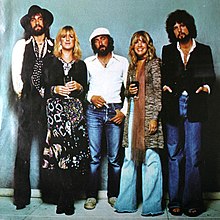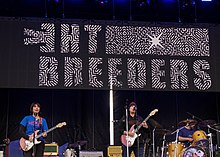Mixed-gender band



A mixed-gender band is a musical group in popular music that is composed of both male and female musicians, including instrumentalists, and is not entirely limited to vocalists, the latter being a co-ed group. Historically, such arrangements have been rare, with a substantial majority of bands being all male. This has been attributed to both social pressures making males more likely to take up musical instruments typical of a band such as guitars and drums, and the history of forming bands as an exercise in male bonding. Most mixed-gender bands feature a lineup of male instrumentalists with one female member as lead vocalist. A smaller number of mixed-gender bands feature multiple female members, or female members performing primarily as instrumentalists.
History and reception
[edit]All-male bands are the most common in many rock and pop scenes, with all-female bands being substantially less common, and historically often viewed as a novelty rather than as serious musicians. Mixed-gender bands occupy a numerical middle-ground between them, with one source noting that "few bands in rock history have achieved a gender balance in the mix of musicians".[1]: 87 In the 1960s pop music scene, "[s]inging was sometimes an acceptable pastime for a girl, but playing an instrument...simply wasn't done".[2] "The rebellion of rock music was largely a male rebellion; the women—often, in the 1950s and '60s, girls in their teens—in rock usually sang songs as personæ utterly dependent on their macho boyfriends...".[3] Philip Auslander says that "Although there were many women in rock by the late 1960s, most performed only as singers, a traditionally feminine position in popular music". Though some women played instruments in American all-female garage rock bands, none of these bands achieved more than regional success. So they "did not provide viable templates for women's on-going participation in rock".[4]: 2–3 When singer and bass guitarist Suzi Quatro emerged in 1973, "no other prominent female musician worked in rock simultaneously as a singer, instrumentalist, songwriter, and bandleader".[4]: 2 According to Auslander, she was "kicking down the male door in rock and roll and proving that a female musician ... and this is a point I am extremely concerned about ... could play as well if not better than the boys".[4]: 3
In relation to the gender composition of heavy-metal bands in particular, it has been said that "[h]eavy metal performers are almost exclusively male"[5] "...[a]t least until the mid-1980s"[6] apart from "...exceptions such as Girlschool".[5] However, "...now [in the 2010s] maybe more than ever–strong metal women have put up their dukes and got down to it",[7] "carv[ing] out a considerable place for [them]selves."[8]
As of 2014[update], it was noted that "few women have ever been allowed entrée into the male rock band and certainly not on equal footing with the male players".[1]: 81 In 2017, The Guardian noted that a substantial majority of popular music bands (as opposed to solo performers) were still composed of an all-male lineup, and that in examining 370 performances in the country on a typical day "of the 82 mixed-gender acts, just under three-quarters contain no more than one woman in the line-up".[9] With the proliferation of all-male and all-female bands, it has been suggested that society may "tend to overlook bands made up of mixed gendered members", but that "there have been numerous mixed gendered bands who have made immense impact in the music industry".[10]
Some bands have had female members for only a short portion of their existence, such as the Beastie Boys, for whom Kate Schellenbach was the drummer until 1984, when she was fired due to her not fitting into the band's new dynamic as it shifted from punk music to hip hop.[11] The Smashing Pumpkins went through a succession of female bass players—D'arcy Wretzky, Melissa Auf der Maur, Nicole Fiorentino, and Ginger Pooley.[12]
As of 2024[update], the best-selling mixed-gender band of all time is ABBA, followed by Fleetwood Mac, both featuring multiple male and female performers in their lineups.
Common configurations
[edit]The most common configuration of a mixed-gender band is one with several male musicians and one female lead singer. The history of rock has been described as including "a myriad of collectives in which a strong female voice provides the group's identity while being supported by male backing musicians".[13] While some female musicians "have negotiated gender as vocalists in a band, other women vocalists have constructed their identities as solo artists for whom bands are accompaniment".[1]: 80 Jason Lipshutz and Hannah Dailey, in a piece for Billboard wrote that there is "something magical about watching a female artist lead the charge with a group of guys standing behind her onstage".[13]
Women as instrumentalists without lead singing roles in mixed-gender bands are substantially less common. "While the women out front grappled with their various presentations and representations, the women in the band, the instrumentalists, grappled with invisibility and marginalization within their own bands.[1]: 81 Professional women instrumentalists are particularly uncommon in rock genres such as heavy metal, for which "playing in a band is largely a male homosocial activity, that is, learning to play in a band is largely a peer-based... experience, shaped by existing sex-segregated friendship networks.[14]: 101–102 Rock music "...is often defined as a form of male rebellion vis-à-vis female bedroom culture".[14]: 102 In popular music, a gendered "distinction between public (male) and private (female) participation" in music has existed.[14]: 104 "[S]everal scholars have argued that men exclude women from bands or from the bands' rehearsals, recordings, performances, and other social activities",[14]: 102 with women being considered "passive and private consumers of allegedly slick, prefabricated – hence, inferior – pop music..., excluding them from participating as high-status rock musicians."[14]: 104 One of the reasons that mixed-gender bands rarely exist is that "bands operate as tight-knit units in which homosocial solidarity – social bonds between people of the same sex... – plays a crucial role".[14]: 104
Notable examples
[edit]Notable mixed-gender bands include:
Duos
[edit]Trios
[edit]Four or more performers
[edit]- A Perfect Circle
- ABBA[10]
- Ace of Base
- Against Me![17]
- Alabama Shakes[13][17]
- Amaranthe
- Arcade Fire[16]
- Arch Enemy[17]
- The B-52s
- Bikini Kill[1]: 91 [17]
- Black Eyed Peas[10]
- Black Lips
- Blondie[10][13][17]
- The Breeders[1]: 88
- Chic[16]
- The Corrs[10]
- The Cranberries[13][17]
- Crystal Castles[13]
- Dance Hall Crashers
- The Dandy Warhols
- The Dead Weather[13]
- Death Valley Girls
- Echosmith[13][17]
- Evanescence[10][13][17]
- Fitz and the Tantrums
- Fleetwood Mac[1]: 87 [17]
- Florence and the Machine[13][17][16]
- Flyleaf[17]
- Frankie and the Witch Fingers
- Franz Ferdinand
- Garbage[13][17]
- Guano Apes
- Halestorm[17]
- Heart[1]: 87 [10][17]
- Heartless Bastards[13]
- Hole[1]: 88 [13]
- Hunx and His Punx
- Hurray for the Riff Raff[13]
- Illuminati Hotties
- In This Moment[17]
- The Interrupters
- Jefferson Airplane[13]
- Jefferson Starship
- The Julie Ruin
- Katrina and the Waves[10]
- Lush
- Metric
- Miami Sound Machine
- Mindless Self Indulgence
- MisterWives[13]
- New Order
- The New Pornographers
- The Naked Brothers Band
- New Power Generation
- New Years Day[17]
- Nightwish
- No Doubt[10][13]
- Of Monsters and Men
- Pale Waves[17]
- Paramore[10][13][17]
- The Pixies
- The Polyphonic Spree
- Pom Pom Squad
- The Pretenders[13][17]
- The Pretty Reckless[13][17]
- The Revolution
- Quarterflash
- Said the Whale
- Scandal
- Screaming Females[13]
- Selena Gomez & the Scene[13]
- Shannon and the Clams
- Silversun Pickups
- Siouxsie and the Banshees[13][17]
- The Smashing Pumpkins[12]
- Sonic Youth
- Starbenders[17]
- Superchick
- Talking Heads[1]: 82
- Tedeschi Trucks Band
- Tonight Alive[17]
- Within Temptation
- Wet Leg
- X
- X-Ray Spex
Fictional
[edit]- The Archies, from Archie Comics
- Big Fun, from Heathers
- Blue Wells from Fuuka
- The Clash at Demonhead, from Scott Pilgrim vs. the World
- Daisy Jones & the Six
- Downtown Sasquatch, from Degrassi: The Next Generation
- The Fallen Moon from Fuuka
- Gorillaz
- Hep Alien, from Gilmore Girls
- The Heights
- Jabberjaw and the Neptunes, from Jabberjaw
- Jesse and the Rippers, from Full House
- The Partridge Family
- Sex Bob-Omb, from Scott Pilgrim vs. the World
- Zack Attack, from Saved by the Bell
References
[edit]- ^ a b c d e f g h i j Mina Carson, Tisa Lewis, Susan M. Shaw, Girls Rock!: Fifty Years of Women Making Music (University Press of Kentucky, 2014), ISBN 978-0813123103.
- ^ White, Erika (28 January 2015). "Music History Primer: 3 Pioneering Female Songwriters of the '60s | REBEAT Magazine". Rebeatmag.com. Archived from the original on 22 December 2015. Retrieved 2016-01-20.
- ^ Oglesbee, Frank W. (June 1999). "Suzi Quatro: A prototype in the archsheology of rock". Popular Music and Society. 23 (2): 29–39. doi:10.1080/03007769908591731. ISSN 0300-7766.
- ^ a b c Auslander, Philip (28 January 2004). "I Wanna Be Your Man: Suzi Quatro's musical androgyny" (PDF). Popular Music. 23 (1). United Kingdom: Cambridge University Press: 1–16. doi:10.1017/S0261143004000030. S2CID 191508078. Archived from the original (PDF) on 24 May 2013. Retrieved 25 April 2012.
- ^ a b Brake, Mike (1990). "Heavy Metal Culture, Masculinity and Iconography". In Frith, Simon; Goodwin, Andrew (eds.). On Record: Rock, Pop and the Written Word. Routledge. pp. 87–91.
- ^ Walser, Robert (1993). Running with the Devil:Power, Gender and Madness in Heavy Metal Music. Wesleyan University Press. p. 76.
- ^ Eddy, Chuck (1 July 2011). "Women of Metal". Spin. SpinMedia Group.
- ^ Kelly, Kim (17 January 2013). "Queens of noise: heavy metal encourages heavy-hitting women". The Telegraph.
- ^ Larsson, Naomi; Piñeda, Naomi Larsson (October 12, 2017). "Live music acts are mostly male-only. What's holding women back?". The Guardian.
- ^ a b c d e f g h i j k Das, Pranay (March 28, 2015). "10 Best Mixed Gender Rock Bands". Glitzyworld.
- ^ Forget, Thomas (2006). The Beastie Boys. The Rosen Publishing Group. ISBN 9781404205192. Archived from the original on June 25, 2021. Retrieved November 8, 2020.
- ^ a b Kreps, Daniel (May 10, 2010). "Smashing Pumpkins Add New Bassist Nicole Fiorentino". Rolling Stone. Archived from the original on May 20, 2022.
- ^ a b c d e f g h i j k l m n o p q r s t u v w x y z aa ab ac ad ae Lipshutz, Jason; Dailey, Hannah (April 20, 2023). "30 Female-Fronted Bands That Rule". Billboard.
- ^ a b c d e f Julian Schaap and Pauwke Berkers. "Grunting Alone? Online Gender Inequality in Extreme Metal Music" in IASPM Journal. Vol. 4, no. 1 (2014).
- ^ "Karmin: 7 Things You Don't Know About the Pop Duo - ABC News". go.com. Archived from the original on September 27, 2013. Retrieved March 30, 2015.
- ^ a b c d "Musicians call for gender equality ahead of all-male headlined Glastonbury". www.shropshirestar.com. June 26, 2019.
- ^ a b c d e f g h i j k l m n o p q r s t u v w x Gray, Barry (February 18, 2023). "35 Best Female-Fronted Rock Bands". Music Grotto.
